Moths are often overlooked in the animal kingdom, but they are a diverse and fascinating group of insects. While most people associate fur with mammals, there are many moths that are just as fluffy, furry, and fuzzy.
In fact, these specialized scales are what give some moths their distinctive appearance. These hairs can serve a variety of purposes, from insulation to camouflage, and they have made these species a point of fascination and study to lepidopterists throughout the world.
You are reading: The Top 10 Fluffy Furry Fuzzy Moths In The World
In this article, we will explore the top 10 fluffy, furry, and fuzzy moths in the world, including their names, pictures, and interesting facts about each species. Whether you’re a nature lover or just curious about the world around you, these moths are sure to leave you amazed.
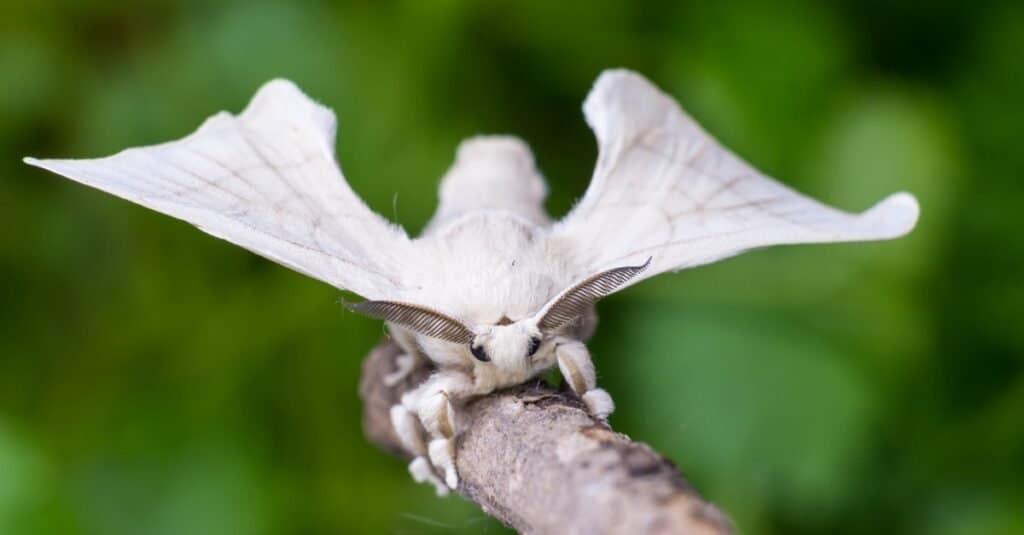
The Top 10 Fluffy Furry Fuzzy Moths In The World
Southern Flannel Moth (Megalopyge opercularis)
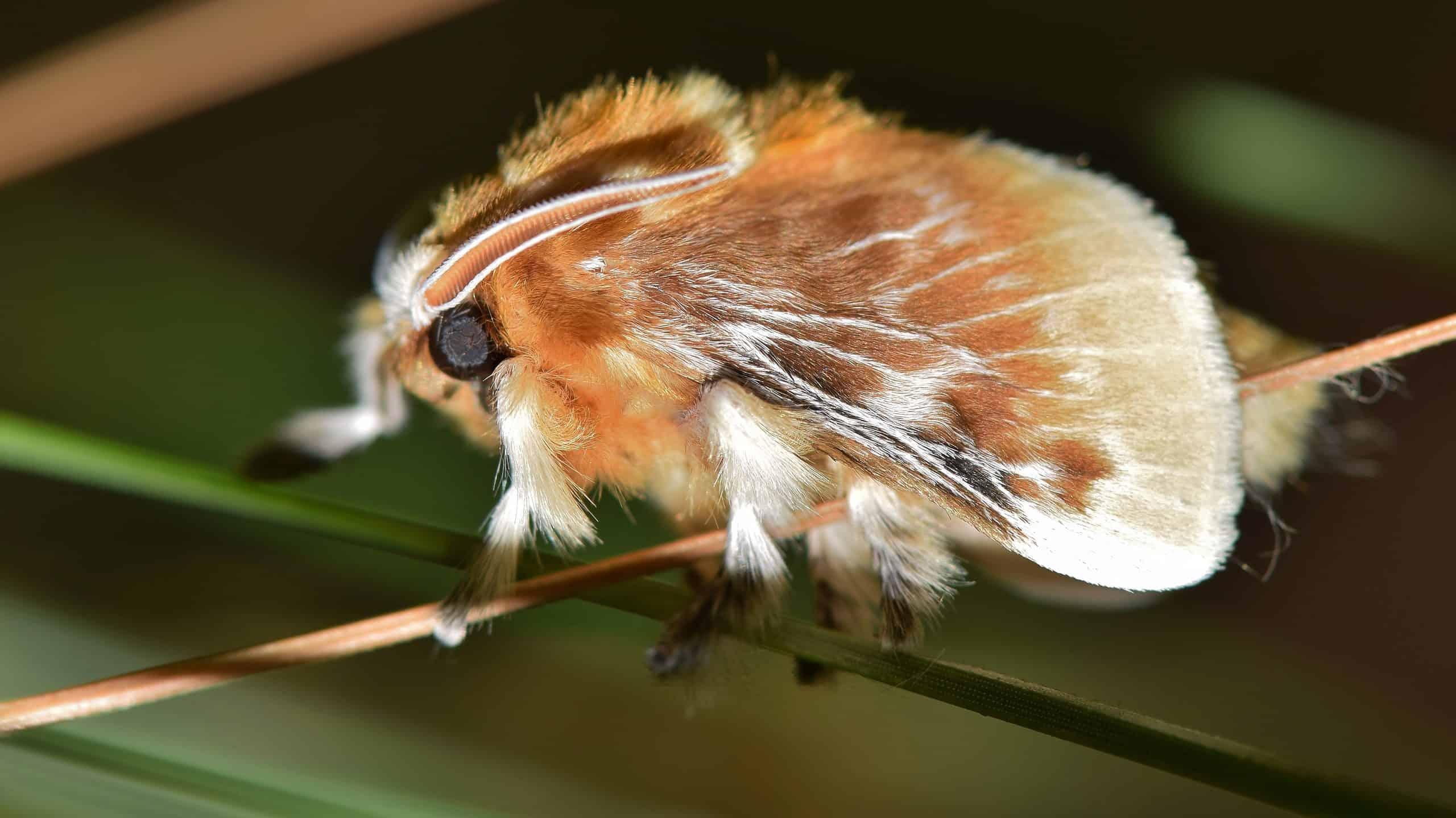
The Southern Flannel Moth (Megalopyge opercularis) is a species of moth native to the Southern United States. It is also known as the puss caterpillar, asp, Italian asp, fire caterpillar, woolly slug, opossum bug, puss moth, tree asp, or asp caterpillar.
The adult moth has a wingspan of 2.4 to 3.6 cm and is golden yellow, grading to paler beige at the rear. The hairy legs are black. Females are larger than males.
The wings and body of the moth are cream-colored, and the thorax and front wings’ base are orangish. Some blackish and white are present along the basal two-thirds of the front wings’ costa, but there is no sharp wing pattern.
The larvae of the Southern Flannel Moth resemble small furry cats and have stinging hairs hidden among tufts of dense, soft hairs. They feed externally on various trees and shrubs, including almond, apple, hackberry, oaks, orange, pecan, persimmon, roses, and other trees and shrubs.
The Southern Flannel Moth is distributed throughout the Eastern United States between extreme southeastern Virginia and Florida across the south to Texas, Mexico, and parts of Central America.
Puss Moth (Cerura vinula)
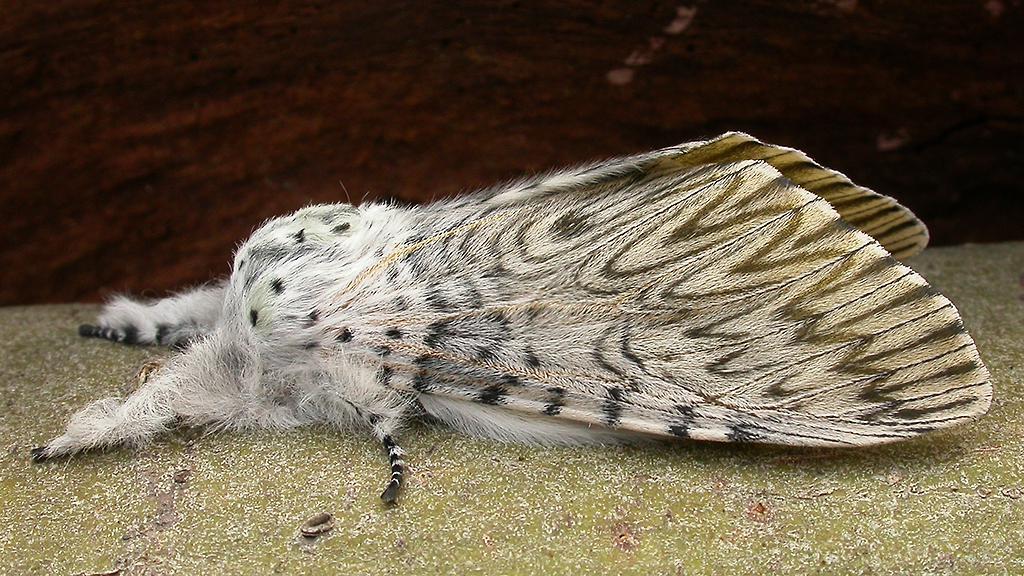
The Puss Moth (Cerura vinula) is a large and fluffy moth that belongs to the Notodontidae family. It is found throughout Europe, Asia, and China.
The Puss Moth was first described by Carl Linnaeus in his 1758 10th edition of Systema Naturae.
The adult moth has a wingspan of 45-75 mm, and the males are slightly smaller than the females.
The head, thorax, and body of the Puss Moth are very fluffy, with a cat-like appearance, which is how it got its common English name.
The antennae of the Puss Moth are bipectinated. The forewings of the Puss Moth are white or yellowish-gray and are crossed by a series of wavy lines.
The Puss Moth caterpillar is also distinctive, with a very strange appearance. It has a large, furry body with a series of long, black spikes protruding from its back. The Puss Moth is fairly common throughout most of Britain and can be found in a wide range of habitats, including gardens, hedgerows, and open woodland.
The adult Puss Moth flies from May to July and is frequently attracted to light.
Overall, the Puss Moth is a fascinating species of moth with a unique appearance that makes it stand out from other moths.
Giant Leopard Moth (Hypercompe scribonia)
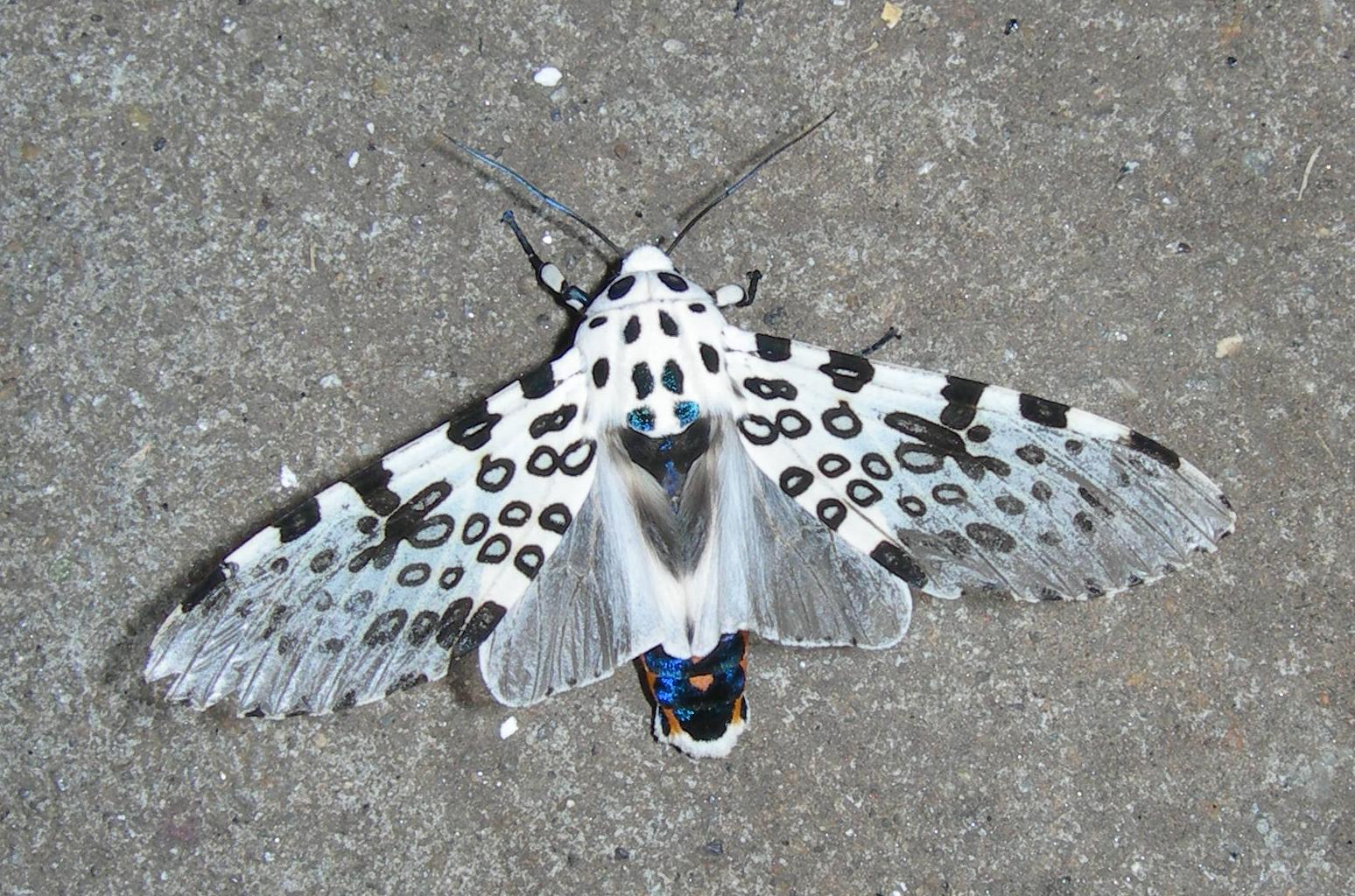
The Giant Leopard Moth (Hypercompe scribonia) is a strikingly patterned moth that belongs to the Erebidae family.
The adult moth has a wingspan of 2.5 to 3.5 inches and is easily recognized by its white wings with hollow bluish-black spots on the forewing.
The wings of the Giant Leopard Moth are covered in scales that are arranged in a way that gives the moth a fuzzy appearance. The caterpillar of the Giant Leopard Moth is known as the “woolly bear” and is mostly black with tufts of stiff black hairs of equal length radiating around its body.
The Giant Leopard Moth is found from southern Ontario south to Florida and west to Minnesota and Texas. The caterpillar of the Giant Leopard Moth feeds on a variety of plants, including dandelion, plantain, and clover.
The Giant Leopard Moth is frequently attracted to lights and can often be found near homes and other buildings.
The adult moth is active from May to October and is commonly found in open woodlands, fields, and gardens.
Read more : Discover The 5 Types Of Rattlesnakes In Oklahoma
Overall, the Giant Leopard Moth is a fascinating species of moth with a unique appearance that makes it stand out from other moths.
Rosy Maple Moth (Dryocampa rubicunda)
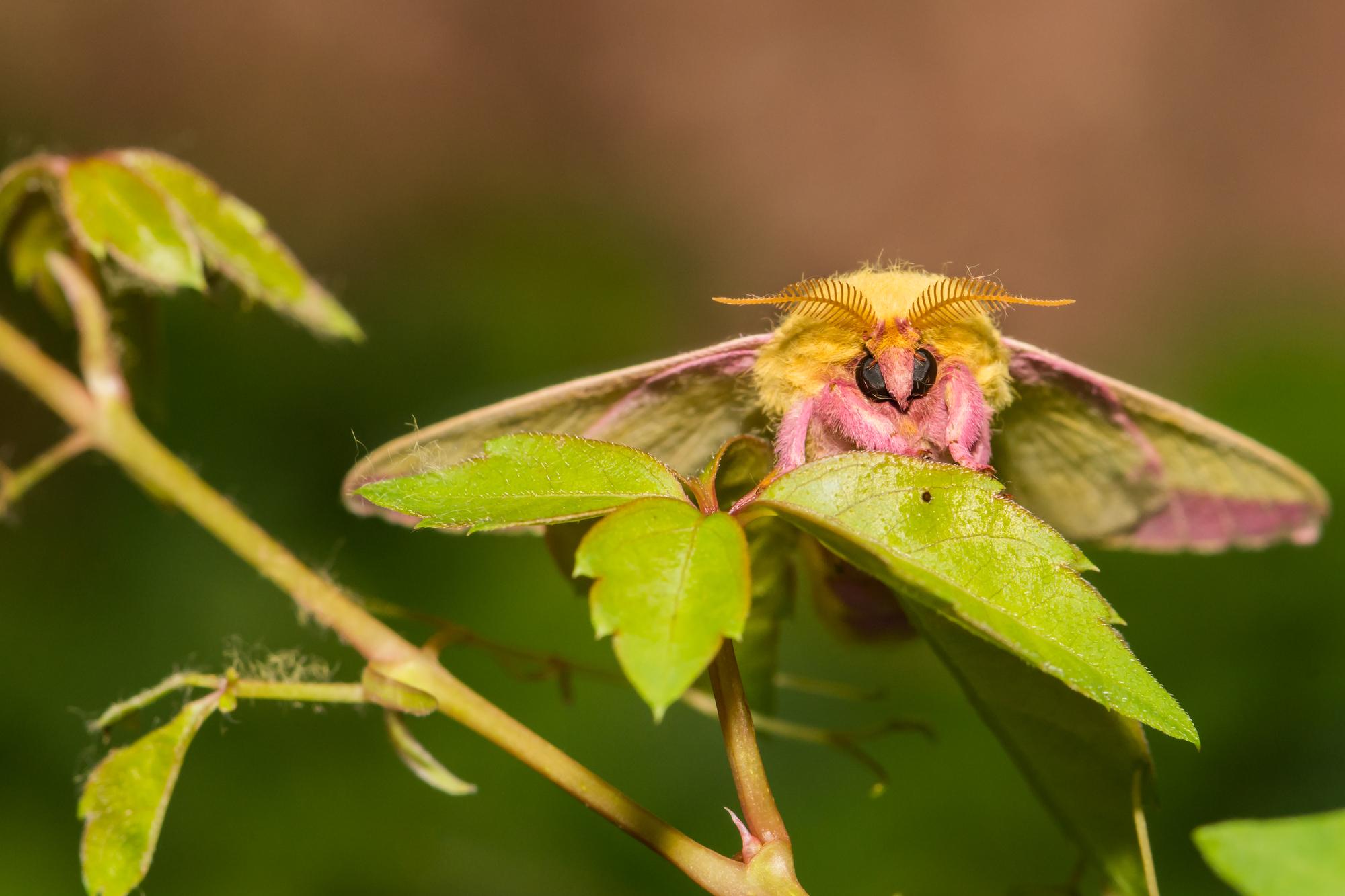
The Rosy Maple Moth (Dryocampa rubicunda) is a small North American moth in the family Saturniidae, also known as the great silk moths. The Rosy Maple Moth is found throughout North America, from Nova Scotia to Florida and west to Minnesota and Texas.
The adult moth has a wingspan of 1.25-2 inches and is easily recognized by its unique, but varying, pink and yellow coloration. The adult moth is active from May to August in the north and from April to September in the south.
The Rosy Maple Moth is known for its wooly body and pink and yellow coloration, which varies from cream or white to bright pink or yellow.
Males have bushier antennae than females, which allow them to sense female pheromones for mating.
The Rosy Maple Moth caterpillar is known as the “greenstriped mapleworm” and is bright neon green with faded white stripes and black dots running horizontally along its body.
The caterpillar feeds on a variety of maple and oak trees, including red maple, sugar maple, silver maple, and turkey oak. The Rosy Maple Moth is not considered a pest, but its caterpillars have been known to cause damage to maple trees.
Overall, the Rosy Maple Moth is a beautiful and unique species of moth that is easily recognized by its pink and yellow coloration.
White-Marked Tussock Moth (Orgyia leucostigma)
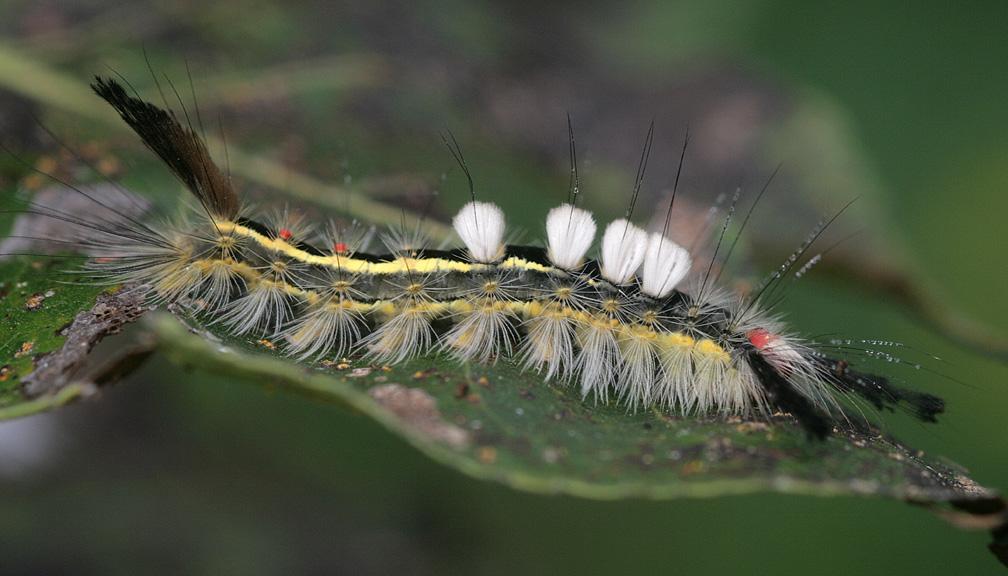
The White-Marked Tussock Moth (Orgyia leucostigma) is a moth species in the family Erebidae. The White-Marked Tussock Moth is found throughout eastern North America, extending as far west as Texas, California, and Alberta.
The adult moth has a wingspan of 2.5-3.5 cm (male), and the females lack wings. The adult moth is active from June to October.
The males are gray with wavy black lines and a white spot on the forewings, while the females are wingless and do not leave the vicinity of the cocoon. The antennae of the White-Marked Tussock Moth are very feathery.
The caterpillar of the White-Marked Tussock Moth is hairy and has four tufts of long, white hairs on its back and two tufts of shorter, yellow hairs on its head.
The caterpillar feeds on a variety of trees, including oak, maple, and birch. The White-Marked Tussock Moth is sometimes considered a pest on Christmas tree plantations in its range.
Overall, the White-Marked Tussock Moth is a common moth species in eastern North America, known for its distinctive caterpillar and feathery antennae.
Io Moth (Automeris io)
The Io Moth (Automeris io) is a colorful North American moth in the family Saturniidae.
The Io Moth is also known as the peacock moth and is a member of the subfamily Hemileucinae. The name “Io” comes from Greek mythology, in which Io was a mortal lover of Zeus.
The Io Moth ranges from the southeast corner of Manitoba and in the southern extremes of Ontario, Quebec, New Brunswick, and Nova Scotia in Canada, and in the US it is found from Montana, North Dakota, South Dakota, Nebraska, Colorado, New Mexico, Texas, Utah, east of those states, and down to the southern end of Florida.
The adult Io Moth has a wingspan of 2.5-3.5 inches and is easily recognizable by its colorful wings, which are usually reddish-brown with a large, prominent eyespot on each hindwing. Both male and female adult Io Moths utilize their hindwings to flash the eyespots as a defense mechanism against predators.
The Io Moth caterpillar is also well-known because of its painful sting, which is caused by venomous spines on its body. The Io Moth is less common now in parts of its range, and its populations have declined in the Gulf States since the 1970s.
Overall, the Io Moth is a beautiful and fascinating species of moth with a unique defense mechanism and a connection to Greek mythology.
Yellow Woolly Bear Moth (Spilosoma virginica)
The Yellow Woolly Bear Moth (Spilosoma virginica) is a species of moth in the subfamily Arctiinae.
The Yellow Woolly Bear Moth is also known as the Virginian tiger moth. As a caterpillar, it is known as the yellow woolly bear or yellow bear caterpillar.
The caterpillar of the Yellow Woolly Bear Moth is hairy and has a yellow or orange body with black tufts of hair.
The caterpillar feeds on a variety of plants, including dandelion, clover, and grasses.
The adult Yellow Woolly Bear Moth has a wingspan of 1.5-2 inches and is white with a darker-colored abdomen. The adult moth tends to tent its wings over its back, rather than sitting with them spread.
Read more : 7 Types Of Cobras
The Yellow Woolly Bear Moth is found throughout eastern North America, from southern Canada to Florida and west to Texas.
Overall, the Yellow Woolly Bear Moth is a common and recognizable species of moth in eastern North America, known for its distinctive caterpillar and white adult moth with a darker abdomen.
Hickory Tussock Moth (Lophocampa caryae)
The Hickory Tussock Moth (Lophocampa caryae) is a moth species in the family Erebidae and the tribe Arctiini. The Hickory Tussock Moth is also known as the hickory tiger moth or hickory halisidota. The adult moth has a wingspan of 37-55 mm.
The wings of the Hickory Tussock Moth are white with black spots, and the body is covered in long, white hairs. The caterpillar of the Hickory Tussock Moth is black with white and yellow stripes and has long, white hairs.
The caterpillar feeds on the leaves of a variety of trees, including ash, oak, hickory, maple, and elm.
The Hickory Tussock Moth is widely distributed in the eastern half of North America, from southern Canada to Florida and west to Texas. The Hickory Tussock Moth is not considered a pest, but its caterpillars have been known to cause defoliation of trees.
Overall, the Hickory Tussock Moth is a distinctive and widespread species of moth in eastern North America, known for its white wings with black spots and long, white hairs.
Black-Waved Flannel Moth (Megalopyge crispata)
The Black-Waved Flannel Moth (Megalopyge crispata) is a moth species in the family Megalopygidae. The Black-Waved Flannel Moth is also known as the crinkled flannel moth or white flannel moth.
The adult moth has a wingspan of 25-40 mm and is small and creamy white with three wavy black lines that run along the outer edge of each forewing. The adult moth is active from May to October, and there is one generation per year in the north and two or more in the south.
The Black-Waved Flannel Moth is found along the east coast of the United States, and as far inland as Oklahoma. The stinging larvae of the Black-Waved Flannel Moth feed on various trees and shrubs.
The Black-Waved Flannel Moth is not considered a pest, but its caterpillars have been known to cause skin irritation and allergic reactions in some people. The Black-Waved Flannel Moth is a beautiful and unique species of moth, known for its creamy white body and black wavy lines on its wings.
Overall, the Black-Waved Flannel Moth is a fascinating species of moth with a unique appearance and a reputation for causing skin irritation.
Sycamore Tussock Moth (Halysidota harrisii)
The Sycamore Tussock Moth (Halysidota harrisii) is a moth species in the family Erebidae and the tribe Arctiini.
The Sycamore Tussock Moth is also known as the sycamore tiger moth. The adult moth has a wingspan of 1.5-2 inches and is white with black spots and tufts of hair on its body.
The Sycamore Tussock Moth is found in southeastern Canada, the eastern parts of the United States, and northeastern Mexico. The caterpillar of the Sycamore Tussock Moth is black with white and yellow stripes and has long, black tufts of hair.
The caterpillar feeds on the leaves of the American sycamore tree (Platanus occidentalis).
The Sycamore Tussock Moth produces two generations each year, with moths emerging from overwintering cocoons from May to June.
The larvae feed in groups and can cause defoliation of sycamore trees. An overpopulation of the Sycamore Tussock Moth can be damaging to sycamore trees.
Overall, the Sycamore Tussock Moth is a common and recognizable species of moth in eastern North America, known for its distinctive white wings with black spots and tufts of hair on its body.
FAQS
1. What are fluffy, furry, and fuzzy moths?
Fluffy, furry, and fuzzy moths are species of moths that have a distinctive appearance due to specialized scales that give them a fluffy, furry, or fuzzy appearance.
2. Are these moths found all over the world?
Yes, these moths are found all over the world, and many of them are also colorful in a way that would seemingly make them sitting ducks for any predator.
3. What is the difference between fur and the hair-like scales on these moths?
Although the hair-like scales on these moths are structurally a type of hair, they are quite different from hair as mammals have it. Instead, these hairs are classified as a type of scale, and they can serve a variety of different purposes depending on the species.
4. Are these moths harmful to humans?
While most of these moths are harmless to humans, some of their caterpillars have stinging hairs that can cause skin irritation and allergic reactions in some people.
5. What do these moths eat?
The diet of these moths varies depending on the species. Some of them feed on trees and shrubs, while others feed on nectar and pollen.
6. Where can I find these moths?
These moths can be found in a variety of habitats, including gardens, woodlands, and fields. The specific species you may find will depend on your location and the time of year.
Source: https://petstutorial.com
Category: Animals










